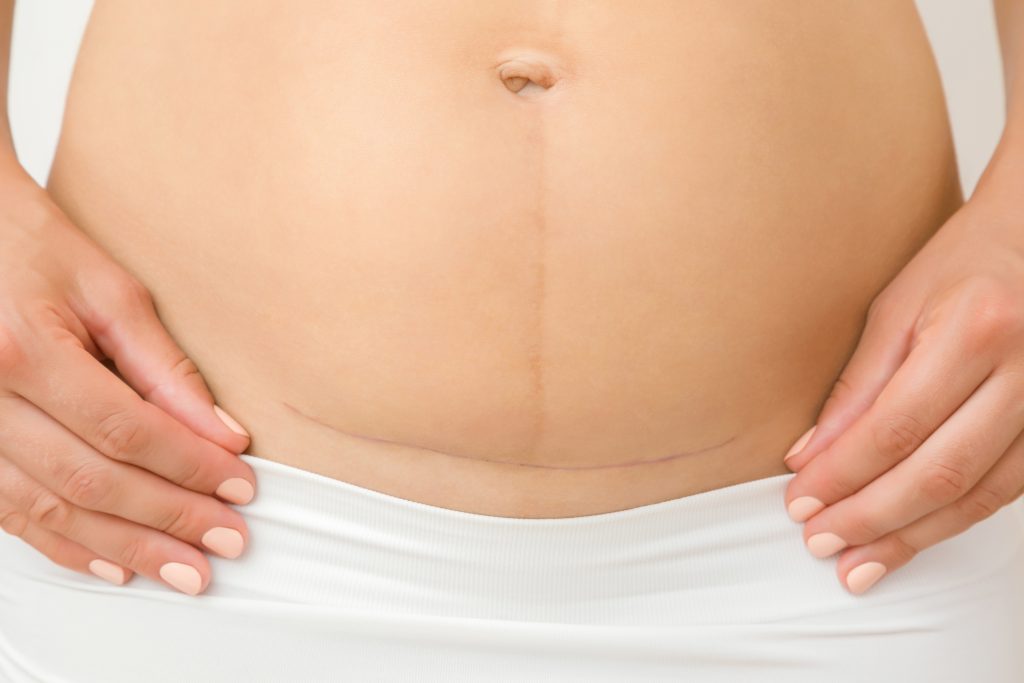Home | Specialties | Physical Therapy | Women’s Health
Women's Health
Women’s health physical therapy is a specialized branch of physical therapy that focuses on addressing the unique health and musculoskeletal needs of women throughout different stages of their lives. It aims to promote, restore, and maintain optimal physical function and overall well-being for women.


The steps involved may vary depending on the specific technique being used and the individual’s condition:
Initial Assessment:
The physical therapist conducts a comprehensive assessment to evaluate the woman’s condition, understand her medical history, and identify any specific concerns or complications related to the C-section surgery. This assessment includes evaluating pain, wound healing, range of motion, muscle strength, and pelvic floor function.
Pain Management:
The therapist provides pain-relief strategies to manage post-C-section discomfort. This may involve techniques such as therapeutic modalities, gentle manual therapy, and appropriate positioning to ease pain and promote comfort.
Scar Management:
Physical therapists can address scar tissue concerns through scar mobilization techniques. These gentle manual techniques help promote proper scar healing, reduce adhesions, and improve tissue mobility around the incision site.
Core and Pelvic Floor Rehabilitation:
Physical therapists design exercises to strengthen the core and pelvic floor muscles gradually. Strengthening these muscles helps women regain stability, support, and control after C-section surgery, preventing issues like diastasis recti and promoting pelvic health.
Breathing and Coughing Techniques:
Proper breathing and coughing techniques are crucial to prevent complications and minimize strain on the incision. The physical therapist teaches women how to breathe effectively and cough with care to protect the abdominal area during healing.
Mobility and Body Mechanics:
The therapist provides guidance on proper body mechanics and movement strategies to avoid undue stress on the incision and surrounding tissues during daily activities like getting in and out of bed, standing, sitting, and lifting.
Gradual Return to Exercise:
Physical therapists design a safe and progressive exercise program based on the individual’s condition, the surgeon’s recommendations, and the woman’s goals. A gradual return to exercise helps prevent complications and supports a successful recovery.
Posture Correction:
Following a C-section, women may experience changes in posture due to pain and altered muscle function. The physical therapist assesses posture and provides exercises and education to improve alignment and reduce strain on healing tissues.
Education and Self-Care:
Physical therapists educate women about self-care strategies, such as wound care, activity progression, and pain management techniques, to support their recovery at home.
Emotional Support:
Physical therapists provide emotional support throughout the recovery process, addressing any concerns or anxieties related to post-surgery healing and rehabilitation.
Follow-up and Progress Monitoring:
The therapist schedules follow-up sessions to monitor progress, reassess the woman’s condition, and adjust the treatment plan as needed.
Home Exercise Program:
The physical therapist provides a personalized home exercise program that complements the in-clinic sessions. Regularly performing these exercises helps maintain progress and further supports the recovery process.

The steps involved may vary depending on the specific technique being used and the individual’s condition:
Initial Assessment:
The physical therapist conducts a comprehensive assessment to evaluate the woman’s physical condition, medical history, and any specific musculoskeletal concerns related to pregnancy. This assessment includes evaluating posture, pelvic alignment, muscle strength, and flexibility.
Exercise Program:
The physical therapist designs a safe and tailored exercise program to support the woman’s changing body during pregnancy. The program focuses on maintaining strength, flexibility, and stability to alleviate common pregnancy-related discomforts and prepare for childbirth.
Pelvic Floor Exercises:
The therapist educates the woman on pelvic floor exercises to improve pelvic floor muscle function and prevent issues like urinary incontinence. These exercises help support the growing uterus and promote pelvic health during and after pregnancy.
Postural Education:
The physical therapist provides guidance on maintaining proper posture during daily activities to reduce strain on the spine and pelvis, especially as the woman’s body undergoes changes due to pregnancy.
Body Mechanics Training:
The therapist teaches proper body mechanics for tasks like lifting, carrying, and getting in and out of bed to protect the spine and pelvis during pregnancy.
Breathing Techniques:
The physical therapist may introduce diaphragmatic breathing techniques to help the woman manage stress, improve oxygenation, and reduce tension.
Pain Management:
If the woman experiences musculoskeletal pain during pregnancy, the therapist provides pain-relief strategies, such as gentle manual therapy, therapeutic modalities, and appropriate exercises.

The steps involved may vary depending on the specific technique being used and the individual’s condition:
Postnatal Assessment:
The physical therapist conducts a thorough assessment to evaluate the woman’s postnatal recovery, including abdominal muscle separation (diastasis recti), pelvic floor strength, and any musculoskeletal concerns resulting from childbirth.
Diastasis Recti Rehabilitation:
If diastasis recti is present, the therapist guides the woman through exercises to close the abdominal separation and regain core strength.
Pelvic Floor Rehabilitation:
The therapist helps women rebuild and strengthen their pelvic floor muscles through targeted exercises to promote continence and pelvic health post-childbirth.
Scar Management:
For women who had C-sections, the therapist may provide gentle scar tissue mobilization techniques to improve scar healing and tissue mobility.
Postural Correction:
The physical therapist addresses any postural changes that may have occurred during pregnancy and provides exercises and education to improve alignment and prevent long-term issues.
Gradual Return to Exercise:
The therapist designs a progressive exercise program to gradually reintroduce physical activity after childbirth, taking into account the woman’s recovery, preferences, and any postnatal complications.
Education on Lifting and Carrying:
The physical therapist teaches safe lifting techniques and body mechanics to protect the body while carrying and caring for the newborn.
Emotional Support:
The therapist offers emotional support during the postnatal period, addressing any concerns or anxieties related to recovery and the transition to motherhood.
Infant Care Ergonomics:
The therapist educates the woman on proper ergonomics and body mechanics when caring for the baby, such as during breastfeeding, diaper changing, and holding.
Follow-up and Progress Monitoring:
The therapist schedules follow-up sessions to monitor the woman’s progress, reassess her condition, and adjust the treatment plan as needed.

The steps involved may vary depending on the specific technique being used and the individual’s condition:
Initial Assessment:
The physical therapist conducts a comprehensive assessment to evaluate the woman’s pelvic and abdominal health, medical history, and any specific concerns or symptoms. This assessment includes evaluating pelvic floor muscle strength, tone, and coordination, as well as assessing abdominal muscle function, posture, and any pelvic pain or dysfunction.
Pelvic Floor Exercises:
The therapist provides instruction on pelvic floor exercises, such as Kegels, to improve pelvic floor muscle strength, endurance, and coordination. These exercises are essential for supporting pelvic organs, preventing urinary incontinence, and promoting pelvic health.
Biofeedback Training:
For women having difficulty identifying or engaging their pelvic floor muscles, the therapist may use biofeedback techniques to provide visual or auditory feedback, helping the woman learn to contract and relax the pelvic floor muscles effectively.
Pelvic Floor Relaxation Techniques:
Some women may experience pelvic floor hypertonicity (overactivity), leading to pelvic pain or discomfort. The therapist teaches relaxation techniques to release tension and improve pelvic floor muscle flexibility.
Core Strengthening:
The therapist designs exercises to strengthen the core muscles, including the deep abdominal muscles, obliques, and back muscles. A strong core supports the pelvic organs and reduces the risk of abdominal and pelvic issues.
Diastasis Recti Rehabilitation:
If the woman has diastasis recti (abdominal muscle separation), the therapist provides exercises to address the separation and promote proper abdominal muscle function.
Education on Proper Body Mechanics:
The therapist provides education on proper body mechanics for daily activities, such as lifting, bending, and carrying, to protect the pelvic and abdominal region from strain and injury.
Postural Correction:
The physical therapist addresses any postural issues that may contribute to pelvic or abdominal discomfort and provides exercises and education to improve alignment and reduce strain.
Pain Management:
For women experiencing pelvic or abdominal pain, the therapist offers pain-relief strategies, such as therapeutic modalities, manual therapy, and appropriate exercises.
Behavioral Strategies:
The therapist may address lifestyle factors and habits that can impact pelvic and abdominal health, such as managing fluid intake, diet, and bowel habits.
Relaxation Techniques:
For women experiencing pelvic pain or tension, the therapist may introduce relaxation techniques to reduce stress and promote overall pelvic and abdominal relaxation.
Follow-up and Progress Monitoring:
The therapist schedules follow-up sessions to monitor the woman’s progress, reassess her condition, and adjust the treatment plan as needed.

The steps involved may vary depending on the specific technique being used and the individual’s condition:
Postpartum Assessment:
The physical therapist conducts a comprehensive assessment to evaluate the woman’s overall physical health, pelvic floor function, abdominal strength, and any musculoskeletal issues that may impact her ability to return to sports.
Pelvic Floor Rehabilitation:
If necessary, the therapist provides pelvic floor rehabilitation to address any pelvic floor dysfunction, such as pelvic organ prolapse or urinary incontinence. This may involve specific exercises to strengthen and coordinate the pelvic floor muscles.
Core Strengthening:
The therapist designs an individualized core strengthening program to address any diastasis recti (abdominal muscle separation) and restore abdominal strength and stability.
Gradual Progression:
The therapist guides the woman through a gradual and progressive return to sport plan, considering the specific demands of her chosen activities. This may involve starting with low-impact exercises and gradually increasing intensity and load.
Sport-Specific Training:
The therapist incorporates sport-specific exercises and drills into the rehabilitation program to help the woman regain the necessary skills and movement patterns required for her sport.
Body Mechanics Education:
The therapist educates the woman on proper body mechanics and techniques to prevent injury during physical activities and sports.
Posture Correction:
The therapist addresses any postural issues that may have developed during pregnancy and provides exercises and education to improve alignment and prevent strain on the body.
Injury Prevention:
The therapist focuses on injury prevention strategies, including warm-up routines, proper stretching techniques, and rest and recovery practices.
Pain Management:
If the woman experiences any pain or discomfort during her return to sport, the therapist may use various pain-relief modalities and techniques to manage symptoms.
Mental and Emotional Support:
The therapist provides mental and emotional support to the woman, addressing any concerns or fears she may have related to returning to sports postpartum.
Monitoring Progress:
The therapist regularly monitors the woman’s progress, reassesses her physical condition, and adjusts the treatment plan as needed to ensure a successful and safe return to sport.
Gradual Return:
The therapist emphasizes the importance of listening to her body and gradually increasing activity levels to avoid overexertion and potential setbacks.
